Lallart M. (ed.) Ferroelectrics - Physical Effects
Подождите немного. Документ загружается.

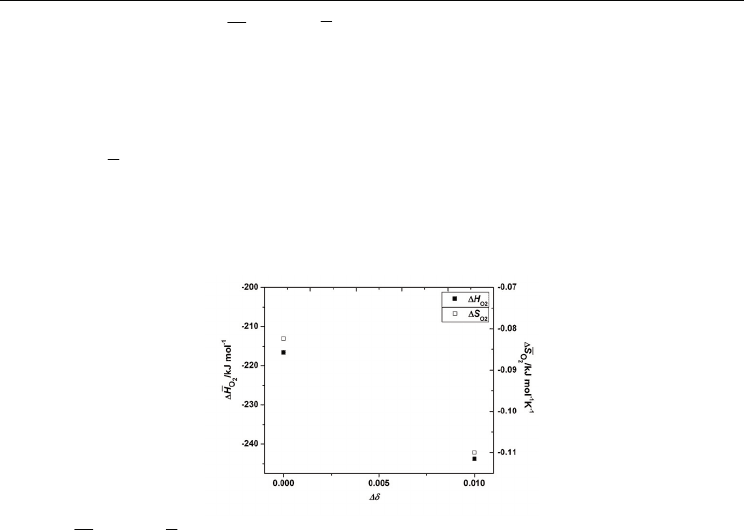
Effects of Doping and Oxygen Nonstoichiometry on the
Thermodynamic Properties of Some Multiferroic Ceramics
359
Regarding the changes of
2
O
HΔ and
2
O
SΔ corresponding to the temperature range of 1093-
1223 K (Fig. 13), one can observe that for Bi
0.90
Ba
0.10
Fe
0.90
Ti
0.10
O
3,
both the variations of
enthalpy and entropy decrease with the stoichiometry change suggesting the increase in the
binding energy of oxygen and the change of order in the oxygen sublattice of the perovskite-
type structure. The values of the relative partial entropies of oxygen dissolution are negative
and this is indicative for a metal vacancy mechanism (Töfield, 1974). Due to the large
decrease in
2
O
SΔ , it is considered that the oxygen vacancies would not randomly distribute
on all of the oxygen sites but they would be distributed to some particular oxygen sites. It is
also possible that the vacancy distribution is related to some crystallographic distortions or
ordering of metal sites.
Fig. 13.
2
O
HΔ and
2
O
SΔ as a function of the oxygen stoichiometry change (Δ
δ
= 0.01)
Presently, however, further details and measurements of the energy and entropy of oxygen
incorporation into BiFeO
3
-based materials
at different values of nonstoichiometry
δ
are
necessary in order to make clear the vacancy distribution with the stoiochiometry change.
3.2 Bi
1-x
La
x
Fe
1-y
Mn
y
O
3
(x=0.1; y=0-0.5)
3.2.1 Phase composition and crystalline structure
The room temperature X-ray diffraction pattern obtained for the presintered sample
corresponding to the mixture 1 (Bi
0.9
La
0.1
FeO
3
) shows a single phase composition, consisting
of the well-crystallized perovskite phase (Fig. 14(a)). A small Mn addition (x ≤ 0.1) does not
change the phase composition. The increase of the manganese amount to x = 0.2 determines
the segregation of a small amount of Bi
36
Fe
2
O
57
secondary phase identified at the detection
limit. For x ≥ 0.4 also small quantities of Bi
2
Fe
4
O
9
was detected as secondary phase,
indicating the beginning of a decomposition process (Fig 14(a)).
From the structural point of view the XRD data pointed out that all the samples exhibit
hexagonal
R3c symmetry, similar to the structure of the paternal non-modified BiFeO
3
compound. Similar to Bi
1-x
Ba
x
Fe
1-x
Ti
x
O
3
solid solutions, the increase of the manganese
content does not determine the change of spatial group. However, certain distortions clearly
emphasized by the cancellation of the splitting of some characteristic XRD peaks take place.
Thus, Fig. 14(b) shows the evolution of the profile and position of the neighbouring (006)
and (202) peaks specific to the Bi
0.9
La
0.1
O
3
composition when Mn is added in the system.
One can observe that an amount of only 10% Mn replacing Fe
3+
in the perovskite structure is
enough to eliminate the (006) peak in the characteristic XRD pattern. A shift of the position
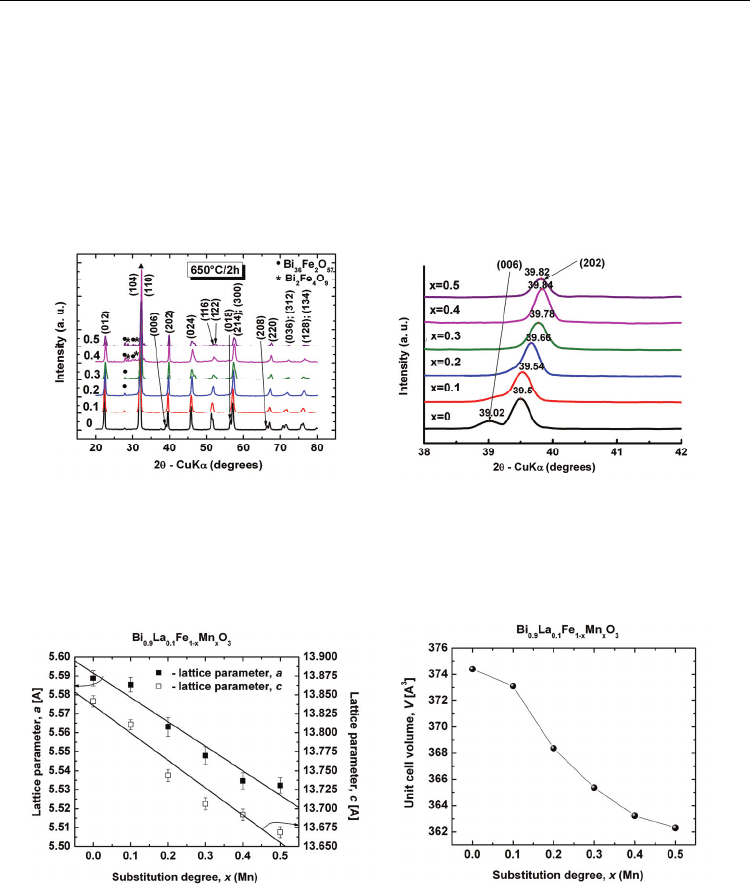
Ferroelectrics
– Physical Effects
360
of the main diffraction peaks toward higher 2
θ values was also pointed out (for exampe the
(002) peak shifts from 2
θ = 39.5
o
for Bi
0.9
La
0.1
FeO
3
to 2θ = 39.82
o
for Bi
0.9
La
0.1
Fe
0.5
Mn
0.5
O
3
).
The increase of the manganese concentration determines the decrease of both a and c lattice
parameters (Fig. 15(a)) and therefore a gradual contraction of the unit cell volume (Fig.
15(b)). This evolution suggests that most of the manganese ions are more probably
incorporated on the
B site of the perovskite network as Mn
4+
, causing the decrease of the
network parameters because of the smaller ionic radius of Mn
4+
(0.60 Å), comparing with
that one corresponding to Fe
3+
(0.64 Å). These results are in agreement with those ones
reported by Palkar et al (Palkar, 2003).
(a) (b)
Fig. 14. (a) Room temperature X-ray diffraction patterns for Bi
0.9
La
0.1
Fe
1-x
Mn
x
O
3
ceramics
thermally treated at 923 K for 2 hours; (b) detailed XRD pattern showing the disappearance
of (0 0 6) peak
(a) (b)
Fig. 15. Evolution of the structural parameters versus Mn content for the Bi
0.9
La
0.1
Fe
1-x
Mn
x
O
3
ceramics sintered at 1073 K for 1 hour: (a) lattice parameters and (b) unit cell volume
3.2.2 Microstructure
As for Bi
1-x
Ba
x
Fe
1-x
Ti
x
O
3
ceramics, SEM analyses were performed firstly on the pellets
surface thermally treated at 923 K/2h. The surface SEM image of the Bi
0.9
La
0.1
FeO
3
sample
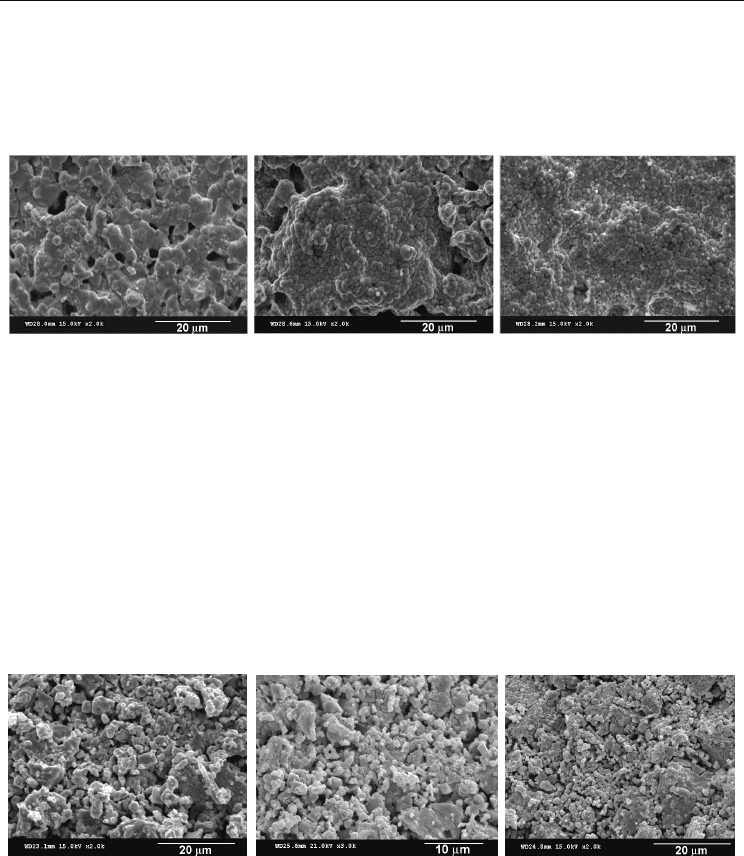
Effects of Doping and Oxygen Nonstoichiometry on the
Thermodynamic Properties of Some Multiferroic Ceramics
361
indicates the obtaining of a non-uniform and porous microstructure, consisting from
grains of variable sizes and a significant amount of intergranular porosity (fig. 16(a)). For
the sample with x = 0.20, the presence of the manganese in the system induces the
inhibition of the grain growth process and has a favourable effect on the densification
(Fig. 16(b)).
Fig. 16. Surface SEM images of: (a) Bi
0.9
La
0.1
FeO
3
; (b) Bi
0.9
La
0.1
Fe
0.8
Mn
0.2
O
3
and (c)
Bi
0.9
La
0.1
Fe
0.5
Mn
0.5
O
3
presintered at 925 K for 2 hours
The further increase of the Mn content to x = 0.50 enhances the densification, but seems to
have not anymore a significant influence on the average grain size. Thus, the
Bi
0.9
La
0.1
Fe
0.5
Mn
0.5
O
3
ceramic shows a dense, fine-grained (average grain size of ~ 2 µm) and
homogeneous microstructure with a monomodal grain size distribution (Fig. 16(c)).
The same trend of the decrease of the average grain size with the addition of both La and
Mn solutes was also observed in the case of the ceramics sintered at 1073 K for 1 hour.
Thereby, unlike the non-homogeneous, rather coarse-grained BiFeO
3
sample (Fig. 5(a)), the
average grain size in the La-modified Bi
0.9
La
0.1
FeO
3
ceramic is of only ~ 4 μm (Fig. 17(a)).
The increase of Mn addition causes a further decrease of the average grain size to ~ 2 μm
and a tendency to coalescence of the small grains in larger, well-sintered blocks (Fig. 17(b)
and 17(c)).
Fig. 17. Surface SEM images of: (a) Bi
0.9
La
0.1
FeO
3
; (b) Bi
0.9
La
0.1
Fe
0.8
Mn
0.2
O
3
and
(c)Bi
0.9
La
0.1
Fe
0.5
Mn
0.5
O
3
ceramics sintered at 1073 K for 1 hour.
3.3.3 Thermodynamic properties of Bi
1-x
La
x
Fe
1-y
Mn
y
O
3
(x=0.1; y=0.2; 0.3)
Emphasizing the role of charge ordering in explaining the magnetotransport properties of
the manganites, Jonker and van Santen considered that the local charge in the doped
manganites is balanced by the conversion of Mn valence between Mn
3+
and Mn
4+
and the
creation of oxygen vacancies, as well (Jonker, 1953). Investigating the influence of the
dopants and of the nonstoichiometry on spin dynamics and thermodynamic properties of
(a) (b) (c)
(a) (b) (c)

Ferroelectrics
– Physical Effects
362
the magnetoresistive perovskites, Tanasescu et al (Tanasescu, 2008, 2009) demonstrated that
the formation of oxygen vacancies and the change of the Mn
3+
/ Mn
4+
ratio on the B-site play
important roles to explain structural, magnetic and energetic properties of the substituted
perovskite.
In BiFeO
3
-BiMnO
3
system was already pointed out that, even though the Mn substitution
does not alter the space group of BiFeO
3
for x ≤ 0.3, the possible variation of the valence
state of Mn manganese together the oxygen hiperstoistoichiometry as a function of
temperature and oxygen pressure could affect the crystallographic properties, electrical
conductivity and phase stability of BiFe
1-x
Mn
x
O
3+
δ
(Selbach, 2009, 2009). Excepting the
communicated results on DSC investigation of Bi
1-x
La
x
Fe
1-y
Mn
y
O
3
(x=0.1; y=0-0.5)
(Tanasescu, 2010), no other work related to the thermodynamic behaviour of Bi
1-x
La
x
Fe
1-
y
Mn
y
O
3
were reported in the literature. In that study the evolution of heat of transformation
and heat capacity in the temperature range of 573 – 1173 K was analyzed. The ferroelectric
transition was shifted to a lower temperature for Bi
0.9
La
0.1
FeO
3
comparative to BiFeO
3
, in
agreement with literature data (Chen, 2008). However, a non-monotonous change of T
C
, as
well as of the thermochemical parameters is registered for the La and Mn co-doped
compositions, depending on the Mn concentration, comparatively with undoped BiFeO
3
. A
sharp decline in the
Tc was pointed out for x=0.3. One reason to explain this behavior is
sustained by the structural results which were already pointed out in the previous section.
The increase of the manganese concentration determines the decrease of both
a and c lattice
parameters and therefore a gradual contraction of the unit cell volume. This evolution
suggests that most of the manganese ions are more probably incorporated on the B-site as
Mn
4+
. Besides, as already was shown, in our samples the decreasing of the average grain
size with the addition of both La and Mn solutes was observed in the case of presintered, as
well as ceramics sintered at 1273 K (Ianculescu, 2009; Tanasescu, 2010). For finer particles
where defect formation energies are likely to be reduced, the lattice defects, oxygen
nonstoichiometry etc. appear to be sizable and significant changes in overall defect
concentration are expected. So, an excess of Mn
4+
ions and an increased oxygen
nonstoichiometry are more likely. Due to the linear relationship between the Mn-O
distortion and the Mn
3+
content, one could expect to find in our samples a strong
dependence of the energetic parameters on the Mn
3+
/ Mn
4+
ratio and the oxygen
nonstoichiometry.
In order to understand how the thermodynamic properties are related to the oxygen and
manganese content in the substituted BiFeO
3
, the thermodynamic properties represented by
the relative partial molar free energies, enthalpies and entropies of oxygen dissolution in the
perovskite phase, as well as the equilibrium partial pressures of oxygen have been obtained
in a large temperature range (923-1123 K) by using solid electrolyte electrochemical cells
method.
The obtained results are plotted in Figures 18 - 20. At low temperatures, between 923 and
~950 K for x=0.3 and between 923 and ~1000 K for x=0.2, the
2
O
ΔG values are increasing
with temperature (Fig. 18(a)). The same trend is accounted for the
2
log
O
p
variation (Fig.
18(b)). The break points at ~963 K and ~993 K obtained for x=0.3 and x=0.2, respectively
(Fig. 18 (a)) are consistent with the Tc values of ferro-para transition in substituted samples.
These values are near the ferroelectric Curie temperatures reported in the literature for
BiFe
0.7
Mn
0.3
O
3
(926-957 K) and BiFe
0.8
Mn
0.2
O
3
(~990 K) with no La addition (Selbach, 2009;
Sahu, 2007). However we have to notice that at the same Mn concentration x=0.3, the Tc
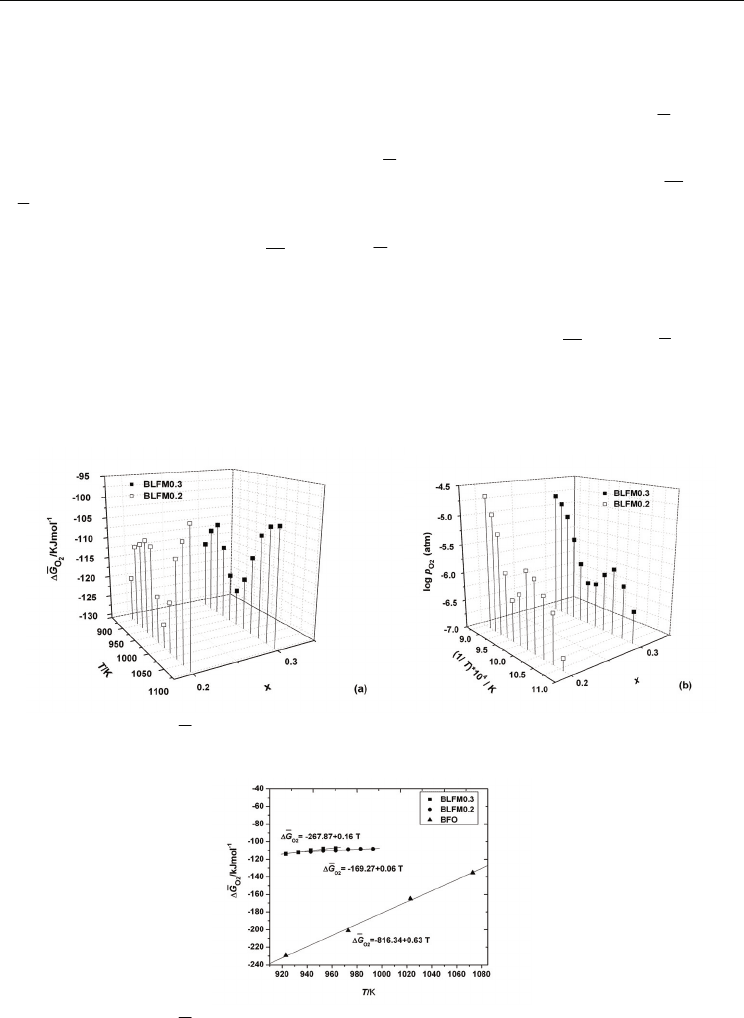
Effects of Doping and Oxygen Nonstoichiometry on the
Thermodynamic Properties of Some Multiferroic Ceramics
363
value is slightly higher for the sample in which lanthanum is present, comparatively with
the sample without La.
In Fig. 19 we represented the partial molar free energies of oxygen dissolution obtained in
this study for Bi
0.9
La
0.1
Fe
0.8
Mn
0.2
O
3
and Bi
0.9
La
0.1
Fe
0.7
Mn
0.3
O
3
samples at temperatures lower
than their specific ferroelectric transition temperatures, and for comparison, the
2
O
ΔG values
of BiFeO
3
. As one can see in Fig. 19, the partial molar free energies of oxygen dissolution in
the substituted samples are highest than the
2
O
ΔG values obtained for BiFeO
3
, suggesting
the increasing oxygen vacancies concentration with doping. Determining the
2
O
HΔ and
2
O
SΔ values in particular temperature ranges until T
C
in which the partial molar free
energies are linear functions of temperature (Figs. 19 and 20) one can observe that for the
substituted compounds, the
2
O
HΔ and
2
O
ΔS values strongly increase in the doped
compounds. Due to the relative redox stability of the B
3+
ions (at the same A-site
composition), both the mobility and the concentration of the oxygen vacancies will be
modified. However it was noticed that the increase in B-site substitution from x = 0.20 to x =
0.30 at temperatures below 1000 K is followed by the decrease of
2
O
HΔ and
2
O
SΔ values
with ~117.6 kJ mol
-1
and ~126 J mol
-1
K
-1
respectively (Fig. 20), suggesting the increase of the
binding energy of oxygen and an increase of order in the oxygen sublattice of the
perovskite-type structure with the Mn concentration.
Fig. 18. Variation of
2
O
ΔG (a) and
2
log
O
p
(b) with temperature and Mn content (x)
Fig. 19. Variation of
2
O
ΔG
with temperature - linear fit in the temperature ranges under the
ferroelectric transition temperatures

Ferroelectrics
– Physical Effects
364
Fig. 20.
2
O
HΔ and
2
O
SΔ as a function of Mn content (x) at temperatures lower than T
C
After the ferroelectric transition temperatures and until 1043 K (for x=0.2), respectively until
1023 K (for x=0.3), a sharp decrease of the
2
O
ΔG values (Fig. 18(a)), together positive values
of the enthalpies and entropies are revealed for both samples, indicating the decreasing of
the thermodynamic driving force for oxygen vacancies formation and low ionic mobility.
Taking into account the working conditions and the existing information as concerns the
phase correlations of systems (Selbach, 2009, 2009, Carvalho, 2008), the dissociation reaction
of the perovskite could be assumed to proceed in this temperature interval, Bi
0.9
La
0.1
Fe
1-
x
Mn
x
O
3
being in equilibrium with other two solid phases, namely
sillenite and mullite type-
phases (Bi
25
Fe
1-y
Mn
y
O
39
and Bi
2
Fe
4-z
Mn
z
O
9
, respectively). Increasing the temperature until
1083 K (for x=0.2) and 1073 K (for x=0.3), the equilibrium will be driven back to the
perovskite formation, the
2
O
ΔG values of the sample with x=0.3 keeping higher than those
of the sample with x=0.2 (Fig. 18(a)). At 1083 K (for x=0.2) and 1073 K (for x=0.3), the
registered
2
O
ΔG values have practically the same values as for the samples before
decomposition. The next phase transition registered at 1093 K for Bi
0.9
La
0.1
Fe
0.7
Mn
0.3
O
3
is
qualitatively in concordance with the transition to the
γ
polymorph which was previously
identified in the literature for BiFeO
3
at 1198-1203K (Arnold, 2010; Palai, 2008; Selbach, 2009)
and for BiFe
0.7
Mn
0.3
O
3
at 1145-1169 (Selbach, 2009). The temperature of transition to the
γ
phase corresponding to Bi
0.9
La
0.1
Fe
0.8
Mn
0.2
O
3
could be higher than 1123 K; it was not
registered in our present experiment because the highest temperature of these
measurements was 1123 K.
The obtained results evidenced the complex behavior of the partial molar thermodynamic
data in substituted samples, suggesting a change of the predominant defects concentration
as a function of temperature range and Mn concentration. Increasing the manganese
content, the decreasing of the ferroelectric Curie temperature and of the transition
temperature from paraelectric to
γ
phase it is noted.
To further evaluate the previous results, the influence of the oxygen stoichiometry change
on the thermodynamic properties has been investigated. The variation of the partial molar
thermodynamic data of Bi
0.9
La
0.1
Fe
0.8
Mn
0.2
O
3
(noted as BLFM0.2) and Bi
0.9
La
0.1
Fe
0.7
Mn
0.3
O
3
(noted as BLFM0.3) was examined before and after two successive titrations by the same
relative oxygen stoichiometry change of
Δ
δ
= 0.02 in the oxygen excess region (Figures 21
and 22). Thus, the effect of the oxygen stoichiometry can be correlated with the influence of
the substituent.
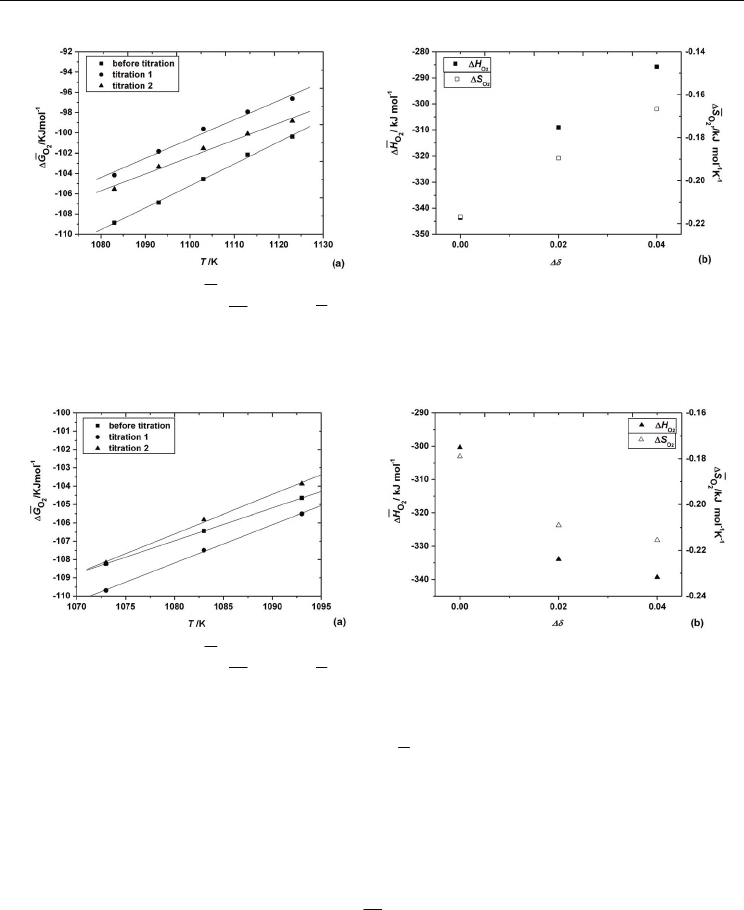
Effects of Doping and Oxygen Nonstoichiometry on the
Thermodynamic Properties of Some Multiferroic Ceramics
365
Fig. 21. (a) Variation of
2
O
ΔG with temperature and oxygen stoichiometry change for
Bi
0.9
La
0.1
Fe
0.8
Mn
0.2
O
3+
δ
; (b)
2
O
HΔ and
2
O
SΔ of Bi
0.9
La
0.1
Fe
0.8
Mn
0.2
O
3+
δ
as a function of the
oxygen stoichiometry change (
Δ
δ
= 0; 0.02; 0.04)
Fig. 22. (a) Variation of
2
O
ΔG
with temperature and oxygen stoichiometry change for
Bi
0.9
La
0.1
Fe
0.7
Mn
0.3
O
3+
δ
; (b)
2
O
HΔ
and
2
O
SΔ
of Bi
0.9
La
0.1
Fe
0.7
Mn
0.3
O
3+
δ
as a function of the
oxygen stoichiometry change (
Δ
δ
= 0; 0.02; 0.04)
For x=0.2 higher values of the partial molar thermodynamic data are obtained after titration
(Fig. 21). It is expected that the change in
2
O
SΔ
with δ in this case to be essentially
determined by the change in S
O
(config) and, therefore, the oxygen randomly distribute on
the oxygen sites. Instead for x=0.3, both the variations of enthalpy and entropy decrease
with the stoichiometry change (Fig. 22(b)), suggesting the increase in the binding energy of
oxygen and change of order in the oxygen sublattice of the perovskite-type structure
comparatively with the undoped compound. However it is interesting to note that the
enthalpies obtained for x=0.3 after the first and the second titrations are near each other,
suggesting a smaller dependence of the
2
O
HΔ on the oxygen stoichiometry change at
higher departure from stoichiometry. This result tends to agree with the assumption that
metal vacancies prevail, since a value for enthalpy which is independent of
nonstoichiometry is expected for randomly distributed and noninteracting metal vacancies
(van Roosmalen, 1994; Tanasescu, 2005). The model based on excess oxygen compensated
by cation vacancies and partial charge disproportionation of manganese ions was also
proposed for other related systems, like LaMnO
3+
δ
(van Rosmallen, 1995; Töpfer, 1997),
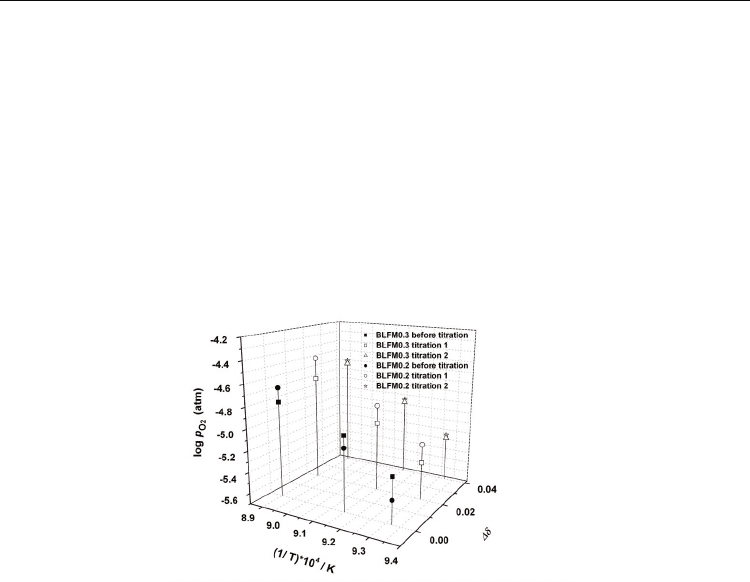
Ferroelectrics
– Physical Effects
366
BiMnO
3+
δ
(Sundaresan, 2008), BiFe
0.7
Mn
0.3
O
3+
δ
(Selbach, 2009)
,
La
0.5
Bi
0.5
Mn
0.5
Fe
0.5
O
3+
δ
(Kundu, 2008). However, the model could not explain the observed relationship in the entire
oxygen-excess region. This statement was also discussed in the case of LaMnO
3+
δ
(Mizusaki,
2000; Nowotny, 1999; Tanasescu 2005) and could be subject for further discussion.
Considering the partial pressure of oxygen as a key parameter for the thermodynamic
characterization of the materials, we investigated the variation of
2
log
O
p
with the
temperature, oxygen stoichiometry and the concentration of the B-site dopant (Fig. 23).
Before titration, the
2
log
O
p
values of the Bi
0.9
La
0.1
Fe
0.7
Mn
0.3
O
3
are higher than
2
log
O
p
for
Bi
0.9
La
0.1
Fe
0.8
Mn
0.2
O
3
, excepting the value at 1123 K which is smaller for x=0.3 comparatively
with the corresponding value for x=0.2, the result being correlated with the structural phase
transformation noted for the composition with x=0.3 under 1123 K.
Fig. 23. Variation of
2
log
O
p
with temperature and oxygen stoichiometry change
It is obtained that for both compounds, after titration, at the same deviation of the oxygen
stoichiometry,
2
log
O
p
shifted to higher values with increasing temperature. At the same
temperature, the high deviation in the
2
log
O
p
values with the stoichiometry change is
obtained for the sample with x=0.2. Besides, at x=0.2, higher values of
2
log
O
p
are obtained
after the second titration, even though, increasing deviation from stoichiometry, a smaller
increase of the partial pressure of oxygen was noted (Fig. 23). This could be explained by the
fact that at high temperature, less excess oxygen is allowed. The sample with x=0.3 presents
a smaller dependence of the
2
log
O
p
on the oxygen nonstoichiometry. For small deviation
from stoichiometry (Δδ=0.02), a small decrease in
2
log
O
p
values is obtained, but after the
second titration, the partial pressure increase again. At 1073 K, after the second titration, the
same value as before titration is obtained. Increasing temperature to 1123 K,
2
log
O
p
values
increase again comparatively with the value before titration.
The obtained results could be correlated with some previously reported conductivity
measurements. Singh et al (Singh, 2007) reported that small manganese doping in thin films
of BiFeO
3
improved leakage current characteristic in the high electric field region, reducing
the conductivity; others authors noted the increasing of the conductivity with increasing
manganese content (Chung, 2006; Selbach, 2009, 2010). If the polaron hopping mechanism is
supposed for the electrical conductivity at elevated temperatures, the electronic conductivity
will increase in the samples with hiperstoichiometry. According to the evolution of the

Effects of Doping and Oxygen Nonstoichiometry on the
Thermodynamic Properties of Some Multiferroic Ceramics
367
partial molar thermodynamic data of the oxygen dissolution, a decrease in the oxygen ionic
conductivity (together the increasing of the electronic conductivity due to the electron-hole
concentration increasing) will result in the sample with increased Mn content.
Even though there are disagreements between different works regarding the nature and the
symmetry of the high temperature phases in the pure and substituted BiFeO
3
, based on our
data, we would like to point out that, in the condition of our experimental work, we may
close to the stability limit of the Mn doped materials at temperatures around 1123 K. This is
in accordance with theoretical consideration of the stability of ABO
3
compounds based on
Goldschmidt tolerance factor relationship (Goldschmidt, 1926). The evolution with
temperature and oxygen stoichiometry of the thermodynamic data suggest that excess
oxygen causing an increase of the tolerance factor of the system will lead to the stabilization
of the cubic phase at lower temperature with increasing the departure from stoichiometry.
At this point further studies are in progress, so that correlations could be established with
the observed properties at different departures of oxygen stoichiometry, in both deficit and
excess region for Bi
0.9
La
0.1
Fe
1-x
Mn
x
O
3
materials.
4. Conclusions
Bi
1-x
Ba
x
Fe
1-x
Ti
x
O
3
(0 ≤ x ≤ 0.30) and Bi
0.9
La
0.1
Fe
1-x
Mn
x
O
3
(0 ≤ x ≤ 0.50) ceramics were prepared
by the conventional mixed oxides route, involving a two-step sintering process. Single phase
perovskite compositions resulted for all the investigated ceramics, in the limit of XRD
accuracy. For both cases, the presence of foreign cations replacing Bi
3+
and/or Fe
3+
in the
perovskite lattice induces the diminishing of the rhombohedral distortion and causes
significant microstructural changes, mainly revealed by the obvious decrease of the average
grain size.
In order to evidence how the appropriate substitutions could influence the stability of the
perovskite phases and then to correlate this effect with the charge compensation
mechanism, the thermodynamic data represented by the relative partial molar free energies,
enthalpies and entropies of the oxygen dissolution in the perovskite phase, as well as the
equilibrium partial pressures of oxygen have been obtained by solid state electrochemical
(EMF) method. The influence of the oxygen stoichiometry change on the thermodynamic
properties was examined using the data obtained by a coulometric titration technique
coupled with EMF measurements.
New features related to the thermodynamic stability of the multiferroic Bi
1-x
Ba
x
Fe
1-x
Ti
x
O
3
and Bi
0.9
La
0.1
Fe
1-x
Mn
x
O
3
ceramics were evidenced, the thermodynamic behavior being
explained not only by the structural changes upon doping, but also by the fact that the
energetic parameters are extremely sensitive to the chemical defects in oxygen sites.
The decreasing of the ferroelectric – paraelectric transition temperature in the substituted
samples was evidenced by both EMF and DSC measurements. Besides, the phase transition
qualitatively corresponding to the phase transformation from paraelectric to a new high
temperature phase was evidenced and the partial molar thermodynamic data describing the
different phase stability domains were presented for the first time.
Bearing in mind the role of charge ordering and of the defects chemistry in explaining the
electrical, magnetic and thermodynamic behavior of the doped perovskite-type oxides, it
should be possible to find new routes for modifying the properties of these materials by
controlling the average valence in B-site and the oxygen nonstoichiometry. Preparation

Ferroelectrics
– Physical Effects
368
method also strongly could influence the behavior of the powder in terms of non-
stoichiometry, which ultimately will affect its electrical properties since they are dependent
upon the presence of oxygen ion vacancies in the lattice. Besides the doping with various
foreign cations, the decreasing of the grain sizes, as well as the thin film technology could be
efficient methods for tuning the electrical, magnetic and thermodynamic properties of
BiFeO
3
-based compounds to be used as multiferroic materials.
5. Acknowledgments
Support of the EU (ERDF) and Romanian Government that allowed for acquisition of the
research infrastructure under POS-CCE O 2.2.1 project INFRANANOCHEM - Nr.
19/01.03.2009, is gratefully acknowledged. This work also benefits from the support of the
PNII-IDEAS program (Project nr. 50 / 2007).
6. References
Arnold, D. C.; Knight, K. S.; Catalan, G.; Redfern, S. A. T.; Scott, J. F.; Lightfoot, P. &
Morrison, F. D. (2010). The β-to-γ transition in BiFeO
3
: a powder neutron diffraction
study.
Advanced Functional Materials, Vol. 20, No. 13, pp. 2116-2123, ISSN 1616-301X
Azuma, M.; Kanda, H.; Belik, A. A.; Shimakawa, Y. & Takano, M. (2007). Magnetic and
structural properties of BiFe
1-x
Mn
x
O
3
, Journal of Magnetism and Magnetic Materials,
Vol. 310, No. 2, Part. 2, pp. 1177 -1179, ISSN 0304-8853
Bogatko, V. V.; Fadeeva, N. V.; Gagulin, V. V.; Korchagina, S. K. & Shevchuk, Y. A. (1998).
Structure and properties of BiFeO
3
-LaMnO
3
seignettomagnetic solid-solutions,
Inorganic Materials, Vol. 34, No. 11, pp. 1141-1143, ISSN 0020-1685
Boyd, G. R.; Kumar, P. & Phillpot, S. R. (2011). Multiferroic thermodynamics,
Materials
Science,
arXiv:1101.5403v1
Buscaglia, M. T.; Mitoseriu, L.; Buscaglia, V.; Pallecchi, I.; Viviani, M.; Nanni, P. & Siri, A. S.
(2006). Preparation and characterization of the magneto-electric xBiFeO
3
–
(1−x)BaTiO
3
ceramics, J. Eur. Ceram. Soc., Vol. 26, No. 14, pp. 3027-3030, ISSN 0955-
2219
Carvalho, T. T. & Tavares, P. B. (2008). Synthesis and thermodynamic stability of
multiferroic BiFeO
3
, Materials Letters, Vol. 62, No. 24, pp. 3984-3986, ISSN. 0167-
577X
Catalan, G. & Scott, J. F. (2009). Physics and application of bismuth ferrite.
Advanced
Materials
, Vol. 21, No. 14, pp. 2463-2485, ISSN: 09359648
Charette, G. G. & Flengas, S. N. (1968). Thermodynamic Properties of the Oxides of Fe, Ni,
Pb, Cu, and Mn, by EMF Measurements, J. Electrochem. Soc., Vol. 115, No. 8, pp.
796-804
Chen, J. R.; Wang, W. L.; Li, J.-B. & Rao, G. H. (2008). X-ray diffraction analysis and specific
heat capacity of (Bi
1−x
La
x
)FeO
3
perovskites, J. Alloys Compd., Vol. 459, No. 1-2, pp.
66-70, ISSN 0925-8388
Chung, C. F.; Lin, J. P.; & Wu, J. M. (2006). Influence of Mn and Nb dopants on electric
properties of chemical-solution-deposited BiFeO
3
films, Appl. Phys. Lett., Vol. 88,
No. 24, pp. 242909.1-242909.3, ISSN 0003-6951
Ederer, C. & Spaldin, N. A. (2005). Weak ferromagnetism and magnetoelectric coupling in
bismuth ferrite,
Phys. Rev., Vol. B 71, No. 6, pp. 060401.1 - 060401.4
